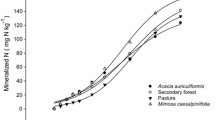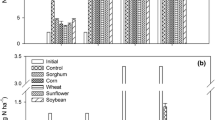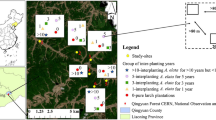Abstract
A laboratory incubation experiment with 15N labeled root and leaf residues of 3 agroforestry species (Leucaena leucocephala, Dactyladenia barteri and Flemingia macrophylla) was conducted under controlled conditions (25 C) for 56 days to quantify residue C and N mineralization and its relationship with residue quality.
No uniform relation was found between the chemical composition of the above and below residues. The leucaena and dactyladenia roots contained more lignin (8 and 26% respectively) and less N (2.0 and 1.0% respectively) than the respective leaves (2 and 13% lignin and 2.9 and 1.4% N, respectively), whereas the differences between the lignin and N contents of the flemingia leaves and roots were not significant (4.6 and 3.0% lignin and 2.63 and 2.68% N, respectively). The leucaena leaves contained more polyphenols than the roots (6.4 and 3.6%), while the polyphenol content of the leaves and roots of the other residues was similar (5.0 and 5.1% for dactyladenia and 4.0 and 3.5% for flemingia).
Three patterns of N mineralization could be distinguished. A first pattern, followed by residues producing the highest amounts of CO2, showed an initial immobilization of soil derived N, followed by a net release of both soil and residue derived N after 7 days of incubation. A second pattern, followed by the flemingia leaf residues which produced intermediate amounts of CO2 and had an intermediate quality, showed no significant immobilization of soil derived N, and significant mineralization of residue N. A third pattern, followed by both low quality dactyladenia residues, showed a low release of residue derived N and a continued inmobilization of soil derived N.
Residue C mineralization was significantly (p<0.05) correlated with the residue lignin content, C-to-N ratio, and polyphenol-to-N ratio. The proportion of residue N mineralized (immobilized) after 56 days of incubation was significantly correlated with the residue N content (p<0.01) and the C-to-N ratio (p<0.05). The relations were quadratic, rather than linear. The ratio of the proportion of residue N mineralized (immobilized) over the proportion of residue C mineralized after 56 days was highly significantly correlated with the lignin content (p<0.01) and C-to-N (p<0.001), lignin-to-N (p<0.01), polyphenol-to-N (p<0.01) and (lignin+polyphenol)-to-N ratios (p<0.01) in a linear way. This indicates that due to the low availability of the residue C, relatively less N is immobilized for the very low quality residues ((lignin+polyphenol)-to-N ratio: 29.7) than for the residues with a relatively higher quality ((lignin+polyphenol)-to-N ratios between 3.3 and 12.5).
Similar content being viewed by others
References
Amato M 1983 Determination of carbon 12C and 14C in plant and soil. Soil Biol. Biochem. 5, 611–612.
Bremner J M and Mulvaney C S 1982 Nitrogen-total. Methods of soil analysis, Part 2. Agron. Monogr. 9, 595–624.
Brooks P D, Stark J M, McInteer B B and Preston T 1989 Diffusion method to prepare soil extracts for automated nitrogen-15 analysis. Soil Sci. Soc. Am. J. 53, 1707–1711.
Bundy L G and Bremner J M 1972 A simple titrimetric method for determination of inorganic carbon in soils. Soil Sci. Soc. Am. Proc. 36, 273–275.
Cotrufo M F, Ineson P and Rowland A P 1994 Decomposition of tree leaf litters grown under elevated CO2: Effect of litter quality. Plant and Soil 163, 121–130.
Fox R H, Myers R J K and Vallis I 1990 The nitrogen mineralization rate of legume residues in soil as influenced by their polyphenol, lignin and nitrogen contents. Plant and Soil 129, 251–259.
Handayanto E, Cadisch G and Giller K E 1994 Nitrogen release from prunings of legume hedgerow trees in relation to quality of the prunings and incubation method. Plant and Soil 160, 237–248.
Hardarson G 1989 The use of nuclear techniques in studies of soil/plant relationships: a training manual. IAEA, Seibersdorf, Austria.
International Institute of Tropical Agriculture 1982 Automated and semi-automated methods for soil and plant analysis. Manual series no. 7, pp 16–18. IITA, Ibadan, Nigeria.
Kachaka S, Vanlauwe B and Merckx R 1993 Decomposition and nitrogen mineralization of prunings of different quality. In Soil Organic Matter Dynamics and sustainability of tropical Agriculture. Eds. K Mulongoy and R Merckx. pp 199–208. John Wiley and Sons, Chichester, UK.
King J G C and Heath G W 1967 The chemical analysis of small samples of leaf material and the relaionship between the disappearance and composition of leaves. Pedobiologia 7, 192–197.
Melillo J M, Aber J D and Muratore J F 1982 Nitrogen and lignin control of hardwood leaf litter decomposition dynamics. Ecology 63, 621–626.
Moormann F R, Lal R and Juo A S R 1974 The soils of IITA. IITA Technical Bulletin No. 3, 26–28. IITA, Ibadan, Nigeria.
Oglesby K A and Fownes J H 1992 Effects of chemical composition on nitrogen mineralization from green manures of seven tropical leguminous trees. Plant and Soil 143, 127–132.
Palm C A 1995 Contribution of agroforestry trees to nutrient requirements of intercropped plants. Agrofor. Syst. 30, 105–124.
Palm C A and Sanchez P A 1991 Nitrogen release from the leaves of some tropical legumes as affected by their lignin and polyphenolic contents. Soil Biol. Biochem. 23, 83–88.
Parton W J, Schimel D S, Cole C V and Ojima D S 1987 Analysis of factors controlling soil organic matter levels in Great Plains Grasslands. Soil Sci. Soc. Am. J. 51, 1173–1179.
SAS Institute Inc. 1985 SAS User's Guide: Statistics, 5 edition. SAS Institute Inc. Cary, NC, USA. 957 p.
Sanginga N, Mulongoy K and Ayanaba A 1986 Inoculation of Leucaena leucocephala (Lam.) de Wit with Rhizobium and its nitrogen contribution to a subsequent maize crop. Biol. Agric. Hortic. 3, 341–347.
Sanginga N, Danso S K A, Zapata F and Bowen G D 1994 Field validation of intraspecific variation in phosphorus use efficiency and nitrogen fixation by provenances of Gliricidia sepium grown in low P soils. Appl. Soil Ecol. 1, 127–138.
Smucker A J M, Ellis B G and Kang B T 1995 Root, nutrient, and water dynamics in alley cropping on an Alfisol in a forest savanna transition zone. In Alley Farming Research and Development. Eds. B T Kang, A Larbi and A O Osiname pp 103–121. AFNETA, IITA Ibadan, Nigeria.
Swift 1985 Tropical soil biology and fertility: plannng for research. Biology International Special Issue 9. IVBS, Paris, France. 24 p.
Swift M J, Heal O W and Anderson J M 1979 Decomposition in Terrestrial Ecosystems. Studies in Ecology, Vol. 5. University of California Press, Berkeley, CA, USA. 372 p.
Tian G, Kang B T and Brussaard L 1992 Effects of chemical composition on N, Ca, and Mg release during incubation of leaves from selected agroforestry and fallow plant species. Biogeochemistry 16, 103–119.
Vanlauwe B, Dendooven L and Merckx R 1994 Residue fractionation and decomposition: The significance of the active fraction. Plant and Soil 158, 263–274.
VanSoest P J 1963 Use of detergents in the analysis of fibrous feeds. II. A rapid method for the determination of fiber and lignin. J. AOAC 46, 829–835.
VanSoest P J and Wine R H 1967 Use of detergents in the analysis of fibrous feeds. IV. Determination of plant cell-wall constituents. J. AOAC 50, 50–55.
Van derMeersch M K, Merckx R and Mulongoy K 1993 Evolution of plant biomass and nutrient content in relation to soil fertility changes in two alley cropping systems. In Soil Organic Matter Dynamics and sustainability of tropical Agriculture. Eds. K Mulongoy and R Merckx. pp 143–154. John Wiley and Sons, Chichester, UK.
Woomer P L and Swift M J 1994 The biological management of tropical soil fertility. John Wiley and Sons, Chichester, UK. 243 p.
Xu Z H, Saffigna P G, Myers R J K and Chapman A L 1993 Nitrogen cycling in leucaena (Leucaena leucocephala) alley cropping in semi-arid tropics. I. Mineralization of nitrogen from leucaena residues. Plant and Soil 148, 63–72.
Yamoah C F, Agboola A A and Mulongoy K 1986 Decomposition, nitrogen release and weed control by prunings of selected alley cropping shrubs. Agrofor. Syst. 4, 239–246.
Author information
Authors and Affiliations
Rights and permissions
About this article
Cite this article
Vanlauwe, B., Nwoke, O.C., Sanginga, N. et al. Impact of residue quality on the C and N mineralization of leaf and root residues of three agroforestry species. Plant Soil 183, 221–231 (1996). https://doi.org/10.1007/BF00011437
Received:
Accepted:
Issue Date:
DOI: https://doi.org/10.1007/BF00011437




